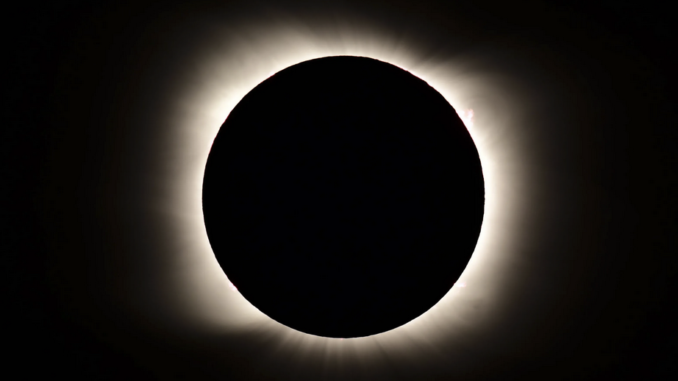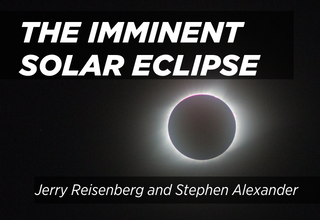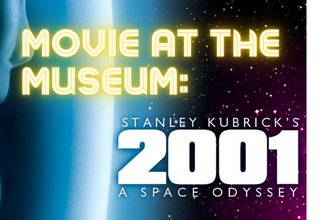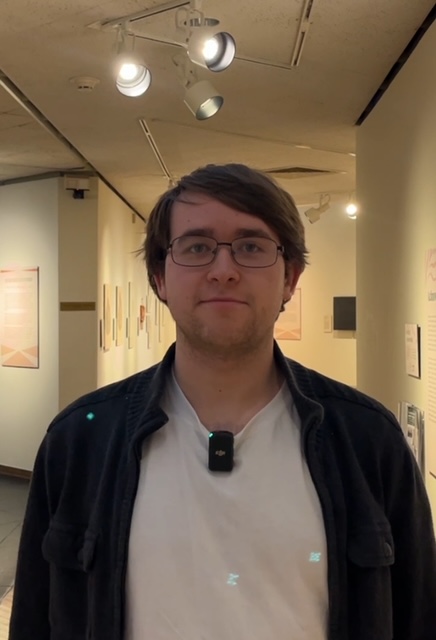
In case you have not heard …
A cosmic event will occur in 2024, in fact it is just DAYS away – and what’s even more special is that it is taking place right here on Miami’s campus! At approximately 3:08 pm on Monday, April 8th, the moon will cast a shadow down on the Oxford community, engulfing us in darkness for more than 3 minutes. A total eclipse happens every year or two on Earth, but scientists say that the Great North American Eclipse of 2024 is extra special.
The Art Museum is excited to host THREE eclipse related events including hosting one of the many amazing Eclipse Watching parties as part of the greater Oxford’s ‘A Total Eclipse of the Parks’ at the sculpture park with food, drinks, and a 2 PM Sculpture Park tour to accompany this once-in-a-lifetime event. We are supplying glasses specifically for watching the eclipsed sun which are available now to be picked up at the front desk (limit 4 per guest) when you sign up to be a Friend of the Art Museum!
Art Museum Event Promo at right by Student Specialist, David Shuppert (@davidshuppART on instagram).
CHECK OUT ALL OF OUR ECLIPSE EVENTS HERE
The Art Museum is excited to not only host the viewing party on April 8, but also has two other events happening – here is the run down and all of the details:

THU, APRIL 4, 4-5:15 PM
Join Jerry Riesenberg, Institute for Learning in Retirement (ILR) and Prof. Stephen Alexander (Department of Physics) for a lecture on the upcoming April 8 solar eclipse, including how best to experience this special astronomical event. This event is in partnership with the Institute for Learning in Retirement (ILR) at Miami University. In person at the Art Museum (Auditorium) and online. Free and open to all. In person spaces may be limited. Participants must pre-register:
Visit this link for registration: https://cvent.me/oL2lZy. Select the registration type of “non-member” in order to waive ILR’s semester fee.

FRI, APRIL 5, 2 PM
“2001: A Space Odyssey” invites you on a profound cinematic odyssey, transporting you to the deepest corners of the universe. With the mastery of visionary director Stanley Kubrick and the profound storytelling of acclaimed author, Arthur C. Clarke, this film transcends convention boundaries. Through this unique event, you’ll gain a fresh perspective on the wonders both on and off our pale blue dot. Picture this epic journey intertwined with the enchanting spectacle of an eclipse.
Snacks and refreshments provided.

MON, APRIL 8, 1-5 PM
A Total Eclipse of the Parks – join us at our Sculpture Park as one of the official viewing locations of the solar eclipse in Oxford. Sculpture Park tours available from 2 PM following an astronomical theme. Totality will occur in Oxford at 3.08 PM. The Art Museum galleries will be open from 1-5 PM though a brief closure will occur during the eclipse (around 2:45-3:30 PM) so all volunteers and staff can participate. Free Eclipse-viewing glasses will be available at the Art Museum during open hours leading up to and on April 8, while supplies last. It is not safe to look directly at the Sun without specialized eye protection for solar viewing. Always follow safe eclipse viewing procedures. Please visit the Oxford City website for more information about the Eclipse event and related activities and viewing locations.
So what is so unique about this event?
The upcoming eclipse is unique due to its path, not just because it’s headed our way, but also because many other cities across the nation will witness it. The path of totality includes Memphis, San Antonio, Quebec, Toronto, Detroit, St. Louis, Louisville, and Houston – with Cincinnati and Columbus as honorable mentions! Additionally, this event is the last total solar eclipse in mainland North America for the next 21 years. Viewing another total solar eclipse would require serious travel, as most occur over the ocean, so make sure you’re in the path of totality this year!
The rarity of this year’s eclipse becomes more special when taking into consideration the moon’s orbit, which is slightly ovular and is either closer or farther away from Earth depending on the time of year. Amazingly, the moon will reach its nearest point during April, meaning that the time of totality will be longer than most of history’s solar eclipses.
The last Great North American Eclipse in 2017 lasted only around 2 minutes. We are incredibly fortunate that this year’s eclipse is nearly two times longer! It gives us more time to view the stars shine through the temporary darkness and the sun’s corona; it will be especially active during the viewing because the sun will be approaching its solar maximum, an activity cycle that lasts 11 years.

David Shuppert (@DavidShuppArt) is a Student Assistant at the Art Museum where he contributes to the RCCAM Marketing and Communications efforts and serves on the Content Team. He enjoys solar eclipses and also making animation graphics!
| SUPPORT US Please visit the Art Museum Giving Page and consider a donation to support RCCAM’s exhibitions, programs, and collections. |
